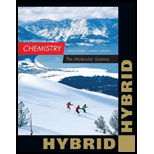
Concept explainers
(a)
Interpretation:
Concept Introduction:
Molar mass can be determined using the given equation,
Ideal gas Equation:
Any gas is described by using four terms namely pressure, volume, temperature and the amount of gas. Thus combining three laws namely Boyle’s, Charles’s Law and Avogadro’s Hypothesis the following equation could be obtained. It is referred as ideal gas equation.
Here,
n is the moles of gas
P is the Pressure
V is the Volume
T is the Temperature
R is the gas constant
(a)
Explanation of Solution
Number of moles of
Number of moles present after vaporization is calculated using Ideal Gas Lew as given below,
Number of moles before and after vaporization are not equal. Hence, decomposition of
(b)
Interpretation:
Partial pressure of each of the gaseous compound has to be calculated.
Concept Introduction:
Mole fraction: Quantity which defines the number of moles of a substance in a mixture divided by the total number of moles of all substances present.
Partial pressure of a gas in the mixture of gases is the product of mole fraction of the gas and the total pressure.
(b)
Answer to Problem 118QRT
Partial pressure of each of the gaseous compound is given below,
Explanation of Solution
Total number of moles is
Initial number of moles of
Change in number of moles of reactants and products can be determined as given below,
According to Dalton’s law, the total pressure exerted by each gas in a mixture is equal to the sum of the individual partial pressure of the gases.
Mole fraction of each of the gaseous compound is calculated as follows,
Partial pressure of each of the gaseous compound is determined as follows,
Want to see more full solutions like this?
Chapter 8 Solutions
Chemistry: The Molecular Science, Hybrid Edition (with OWLv2 24-Months Printed Access Card)
- You have two pressure-proof steel cylinders of equal volume, one containing 1.0 kg of CO and the other containing 1.0 kg of acetylene, C2H2. (a) In which cylinder is the pressure greater at 25 C? (b) Which cylinder contains the greater number of molecules?arrow_forwardA collapsed balloon is filled with He to a volume of 12.5 L at a pressure of 1.00 atm. Oxygen, O2, is then added so that the final volume of the balloon is 26 L with a total pressure of 1.00 atm. The temperature, which remains constant throughout, is 21.5 C. (a) What mass of He does the balloon contain? (b) What is the final partial pressure of He in the balloon? (c) What is the partial pressure of O2 in the balloon? (d) What is the mole fraction of each gas?arrow_forwardA study of climbers who reached the summit of Mount Everest without supplemental oxygen showed that the partial pressures of O2 and CO2 in their lungs were 35 mm Mg and 7.5 mm Hg, respectively. The barometric pressure at the summit was 253 mm Hg. Assume the lung gases are saturated with moisture at a body temperature of 37 C [which means the partial pressure of water vapor in the lungs is P(H2O) = 47.1 mm Hg]. If you assume the lung gases consist of only O2, N2, CO2, and H2O, what is the partial pressure of N2?arrow_forward
 Chemistry: The Molecular ScienceChemistryISBN:9781285199047Author:John W. Moore, Conrad L. StanitskiPublisher:Cengage Learning
Chemistry: The Molecular ScienceChemistryISBN:9781285199047Author:John W. Moore, Conrad L. StanitskiPublisher:Cengage Learning Introductory Chemistry: A FoundationChemistryISBN:9781285199030Author:Steven S. Zumdahl, Donald J. DeCostePublisher:Cengage Learning
Introductory Chemistry: A FoundationChemistryISBN:9781285199030Author:Steven S. Zumdahl, Donald J. DeCostePublisher:Cengage Learning Chemistry: Principles and ReactionsChemistryISBN:9781305079373Author:William L. Masterton, Cecile N. HurleyPublisher:Cengage Learning
Chemistry: Principles and ReactionsChemistryISBN:9781305079373Author:William L. Masterton, Cecile N. HurleyPublisher:Cengage Learning Chemistry & Chemical ReactivityChemistryISBN:9781337399074Author:John C. Kotz, Paul M. Treichel, John Townsend, David TreichelPublisher:Cengage Learning
Chemistry & Chemical ReactivityChemistryISBN:9781337399074Author:John C. Kotz, Paul M. Treichel, John Townsend, David TreichelPublisher:Cengage Learning Chemistry & Chemical ReactivityChemistryISBN:9781133949640Author:John C. Kotz, Paul M. Treichel, John Townsend, David TreichelPublisher:Cengage Learning
Chemistry & Chemical ReactivityChemistryISBN:9781133949640Author:John C. Kotz, Paul M. Treichel, John Townsend, David TreichelPublisher:Cengage Learning Chemistry for Engineering StudentsChemistryISBN:9781337398909Author:Lawrence S. Brown, Tom HolmePublisher:Cengage Learning
Chemistry for Engineering StudentsChemistryISBN:9781337398909Author:Lawrence S. Brown, Tom HolmePublisher:Cengage Learning





